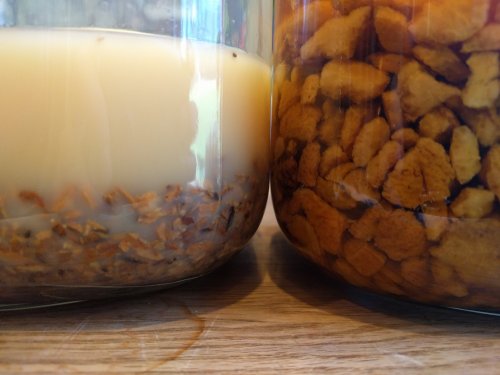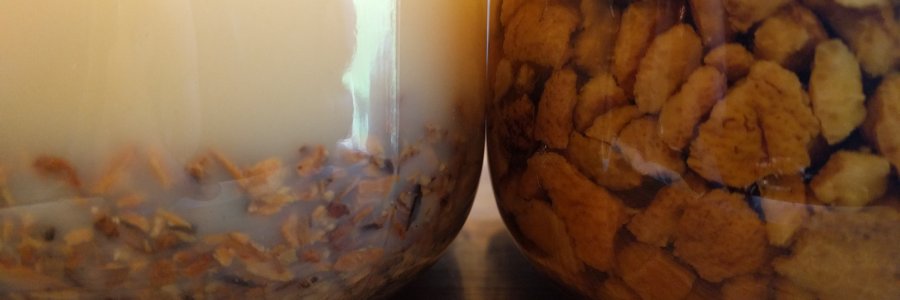Today, it was time to filter and bottle a big batch of gentian tincture. As you may remember, my tincture process is to macerate for 3 weeks at 190 proof, then dilute to 120 proof and macerate for 1 more week. With every tincture, I find that the liquid turns cloudy when I dilute it. This makes perfect sense, since some of the stuff that has dissolved at 190 proof will not be soluble at 120. The gentian tincture took this effect to the extreme, and turned completely white. (Pictured below is the gentian along side some bitter orange.) After a few days, it cleared up and turned dark red.

So, what can I do with a brand new bottle of gentian tincture?
Drambuie-like substance
I recently tried a scotch, honey, and gentian liqueur. I'm not sure what direction I want to go with it yet, but I'm pretty sure I want to keep working on it. Maybe I'll mess around with that tomorrow.
Somewhere between Suze and Campari
Suze is an extremely bitter gentian liqueur. As far as I know, it is made simply from gentian, sugar, and alcohol. I was able to create something roughly equivalent with 1 part gentian tincture, 2 parts simple syrup, and 2 parts water. Roughly equivalent is the key term here. My gentian tastes much rougher than Suze, although not necessarily in a bad way. It's more earthy and slightly more bitter. It was an interesting experiment, but not all that useful. I can just buy Suze.
Next I tried to pull the concoction in the general direction of Campari by adding some orange. The ingredients in Campari are, of course, a heavily guarded secret, but the known ingredients include Cascarilla, a bitter bark, and Chinotto, a bitter orange like fruit. I added 1 part sweet orange tincture, and few drops of bitter orange as an approximation. The result was surprisingly successful. I made a pair of Negronis, one with Campari and one with this stuff. The Campari Negroni was noticeably sweeter and more complex. I added a bit more sugar and bitter orange to the Nonpari Negroni, and the gap close a little bit. My survey results were almost perfectly split. One person liked Campari and hated the other, one liked Nonpari better and didn't hate (but didn't care for) the Campari, and I decided that I liked them both.
I now have something that is different from its commercially available cousins, but I'm not sure it's different enough to be worthwhile yet. To be worth making something this similar, it must be an improvement, which it also is not. What I think I have is something vaguely Suze/Campari like to use as a base. My next step will be to think of something completely different to add to it.
Somewhere between Suze and Cocchi Americano
The reason I made a large batch of gentian tincture in the first place was to make something like Cocchi Americano, but more bitter. Several months ago (before the blog) I made an Americano mock-up with white wine, gentian, and sugar. I wasn't actually trying to replicate the Cocchi Americano, I was just curious to see if I had identified the primary flavors correctly. I think I was pretty close (although I accept that palate bias could have played a role, and I might actually be completely off base.) There was definitely something missing though.
This time around, I realized that there is a distinct note of elderflower to Cocchi Americano. Maybe someday I can produce my own elderflower extract. For now, my only source of the flavor is St. Elder. Here is today's mock-up:
- 2 part white wine
- 1 part St. Elder
- 1/4 part simple syrup
- 1/24 part gentian tincture
The gentian-averse taster liked everything about it but the gentian. I, on the other hand, liked the whole thing quite a bit. It's actually very similar to the original, but a little more bitter, which is exactly what I was hoping for. I have mixed up a small batch, and if I still like it in a few days, I might just add it to the rotation.
